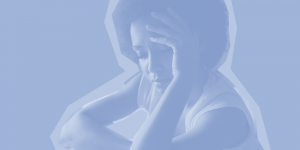PTSD and Addiction
Substance use disorder (SUD) and post-traumatic stress disorder (PTSD) often co-occur.
Research shows that around 47 percent of people with PTSD meet the criteria for SUD, and half of the individuals seeking treatment for addiction also meet the criteria for PTSD.
Table of Contents
What is PTSD?
Post-traumatic stress disorder can be a debilitating condition. Those with PTSD re-experiencing traumatic event(s). These events could be natural disasters, violent or sexual assaults, acts of terrorism, combat, the loss of a loved one, or a number of adverse childhood experiences.
There is a common misconception that only those who have served in the military will acquire PTSD. That is not accurate! According to the National Center for PTSD, only 6 out of every 100 people will experience PTSD. It is more common in women than men. The National Institute on Mental Health (NIMH) indicates that not everyone who experiences a traumatic event will develop PTSD and not everyone with PTSD has been through a dangerous event.
Symptoms of PTSD usually begin within 3 months of a traumatic event, but can arise up to a year later. These symptoms can significantly impair a person’s day-to-day functioning, and many people with one fo these stress disorders will seek to relieve the pain of reliving these experiences through using substances.
Typically, patients are diagnosed by a psychiatrist, or mental health provider using the Diagnostic and Statistical Manual (DSM-5). NIMH has usefully categorized the symptoms as follows. An individual must experience the following PTSD symptoms for at least one month:
- At least one re-experiencing symptom: these symptoms might include flashbacks, bad dreams, frightening thoughts. Sometimes these symptoms are accompanied by a racing heart.
- At least one avoidance symptom: this may include avoiding places associated with the event, avoiding thoughts and feelings related to the event. It can also involve self-medicating with alcohol and substance abuse.
- At least two arousal and reactivity symptoms: this may include feeling tense, or easily startled, having difficulty sleeping, and/or having outbursts.
- At least two cognition and mood symptoms: this might look like difficulty remembering, negative thoughts, loss of interest in enjoyable activities, and other distorted feelings like feeling guilty or ashamed.
The relationship between addiction and PTSD
People with co-occurring PTSD and SUD experience often intense cravings for drugs and alcohol. They also have higher instances of relapse compared to those without PTSD.
Drug and alcohol use can rewire the brain, linking drugs and alcohol to the brain’s reward system. Given the complexity of PTSD and the way substance use changes the brain, it is particularly important to treat both conditions simultaneously.
Treatment of addiction and PTSD
There are a range of treatment options for SUD, including inpatient addiction treatment, digital treatment, and assisted treatment. Usually, these treatments will be combined with behavioral therapies, like cognitive behavioral therapy (CBT), dialectical behavioral therapy (DBT), acceptance and commitment therapy (ACT). It is critical that any treatment is trauma-informed to ensure patients with PTSD do not feel triggered and reduce the risk of re-experiencing symptoms.
A number of other non-facility treatments, including physical exercise, 12-step meetings, and/or medication such as medication-assisted treatment, antidepressants, or anxiety medication.
Workit Health has treatment programs for opioid and alcohol use disorders and some mental health conditions, but does not have a program specifically for PTSD.









